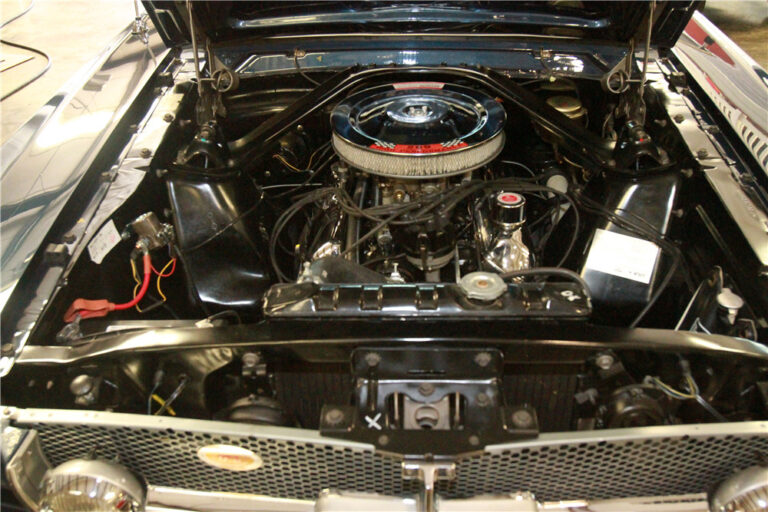Engine Ford V8 289 Hi-Po (K-code)
All you need to know to understand and identify the first ever high performance V-8.

The Ford Small Bloc, originally known as the Fairlane V-8 90 degree, introduced in 1962 with displacements of 221 ci and 260 ci, was truly impressive for its time. It was compact, light, fuel efficient and powerful for its size. It didn’t take long for Ford engineers and designers to realize that this tiny V-8 needed a larger displacement and a fiery temperament.
In 1963, the 289 High Performance V-8 was born in the Ford Fairlane. This 289 HiPo engine was designed to increase performance and reliability at high rpm over the standard 289ci. It featured a mechanical camshaft with flat tappets, 10.5:1 compression, a two-point distributor, smaller combustion chamber heads with molded spring cups and screw-in studs, low-restriction exhaust manifolds, and a larger 595 CFM manual choke carburetor (the standard 289-4V was 480 CFM). The water pump, fuel pump and alternator/generator pulleys were modified, with an extra spring and larger diameter, to help handle the higher engine speeds. Even the 289 HiPo’s fan was unique.
Some of the more significant improvements include a standard block selected without defect, thicker main bearing caps and crankshaft damper/balancer, larger diameter rod bolts, a crankshaft made of 80% nodular cast iron instead of the usual 40%, The increased external front counterweight was split between the crankshaft damper and an additional counterweight adjacent to the front main journal (all designed to reduce the “bending moment” of the crankshaft at high rpm). All this to ensure reliability at high rpm.
The 289 HiPo with a single Autolite 4100 4-barrel carburetor was rated at 271 bhp (202 kW) at 6,000 rpm and 423 Nm at 3,400 rpm.
The 289 HiPo K-code engine was an expensive option and its popularity declined sharply after the introduction of the 390 ci and 428 ci big-block engines in the Mustang and Fairlane, which offered similar power (at the expense of greater weight) but at much lower cost.
Approximately 13,000 289 Hi Po K-code engines were built between March 1963 and June 1967, less than 1% of the 1.8 million Mustangs produced over the same period.
The earliest known Mustang with a “K” serial number is 5F07K100148, a Dearborn pre-production unit built specifically for Henry Ford II prior to the start of mass production at Dearborn on 9 March 1964. Aside from HFII’s unique Hi-Po pony, the first known production Mustangs with a “K” VIN were built in late June 1964 at the Dearborn, Michigan assembly plant, according to Scott McMullen, a Hi-Po historian, who has done a great deal of research on the first Hi-Po engines with a “K” VIN.
Scott says: “I know of no other pre-production ‘K’ units with a VIN other than 100148, although there are several engineering test cars that have been featured in magazine articles. The first of these test cars was a convertible driven by Dan Gurney in February 1964, which he described as a “prototype for production models”. The test units appear to have been built at various times up to June 1964.
Scott goes on to say, “The fourth edition of the Hi-Po register shows that the first four known ID numbers are 158705, 158819, 159122 and 160242, although there is an ID number of 159333 from an engine of unknown origin. The June 8 and 9 date codes (08F and 09F) of this first batch of cars extend to the 162XXX range ID numbers.”
Engine block identification codes:
C3OE-6015-B five-bolt bell housing
C4OE-6015-B five-bolt bell
C4OE-6015-C five-bolt bell
C4OE-6015-F five-bolt bell
C5AE-6015-A six-bolt bell
C5AE-6015-E six-bolt bell
Shelby GT-350
The 289 HiPo engine was used in a modified form by Carroll Shelby for the 1965-1967 Shelby GT350, increasing power output to 306 bhp (228 kW) at 6,000 rpm and torque to 446 Nm at 4,200 rpm, through the use of special exhaust manifolds, an aluminium intake manifold and a larger Holley 715 CFM four-barrel carburettor. The Shelby engine also featured a larger oil pan with baffles to increase oil flow in tight corners. Shelby also replaced the internal front oil gallery plugs with a screw-in type plug to reduce the risk of failure.
From 1966 to 1968, Shelby offered an optional Paxton supercharger for the 289, increasing its power to about 390 hp (291 kW).
We recommend two books :
Mustang & Ford Small-Block V8-1962-’69 by Robert Mannel, published by RPM Press,. Considered the reference for Ford small blocks. Over 3,000 illustrations of all Ford small-blocks from 1962 to 1969 (221/260/289/302/351W small-block V-8), https://fordsmallblock.com/
All you need to know about the 289 High Performance Mustangs. 182 pages of illustrations and explanations. www.cobranda.com/289hipemu.html




